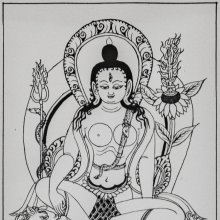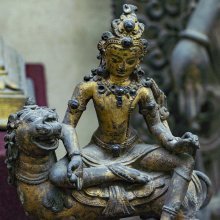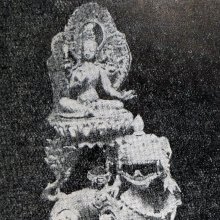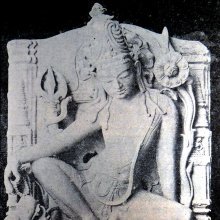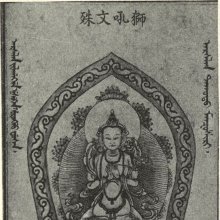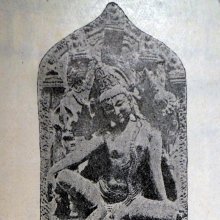Simhanada, Siṃhanāda, Simha-nada: 23 definitions
Introduction:
Simhanada means something in Buddhism, Pali, Hinduism, Sanskrit, Jainism, Prakrit, Marathi. If you want to know the exact meaning, history, etymology or English translation of this term then check out the descriptions on this page. Add your comment or reference to a book if you want to contribute to this summary article.
Images (photo gallery)
(+10 more images available)
In Hinduism
Yoga (school of philosophy)
Source: Google Books: The Khecarividya of AdinathaSiṃhanāda (सिंहनाद):—The small whistle worn on a thread around the neck by Gorakhnāthī Yogīs is called Siṃhanāda (according to the Siddhasiddhāntapaddhati)

Yoga is originally considered a branch of Hindu philosophy (astika), but both ancient and modern Yoga combine the physical, mental and spiritual. Yoga teaches various physical techniques also known as āsanas (postures), used for various purposes (eg., meditation, contemplation, relaxation).
Purana and Itihasa (epic history)
Source: archive.org: Shiva Purana - English TranslationSiṃhanāda (सिंहनाद) refers to a “lion’s roar”, according to the Śivapurāṇa 2.2.37. Accordingly:—“[...] mentally meditating on Śiva, the remover of all adversities and seated in his divine chariot, the powerful Vīrabhadra took up all the great miraculous weapons for his fight with Viṣṇu and roared like a lion (siṃhanāda) [...] The guardians of the quarters including Indra roared like lions (siṃhanāda) and fought forcefully with the Gaṇas of Vīrabhadra”.
Source: Cologne Digital Sanskrit Dictionaries: The Purana IndexSiṃhanāda (सिंहनाद).—(also meghanāda) a war cry;1 made by Kṛṣṇa on seeing the Ariṣṭa bull;2 before wrestling with Cāṇūra.3

The Purana (पुराण, purāṇas) refers to Sanskrit literature preserving ancient India’s vast cultural history, including historical legends, religious ceremonies, various arts and sciences. The eighteen mahapuranas total over 400,000 shlokas (metrical couplets) and date to at least several centuries BCE.
Shaivism (Shaiva philosophy)
Source: DSpace at Pondicherry: Siddha Cult in Tamilnadu (shaivism)Siṃhanāda (सिंहनाद).—Through the horns of the deer, the Siddhas used to make a sound which is similar to the roar of lion (siṃhanāda). However, sometimes these depictions of deer horns are misinterpreted as ‘Chillums’ which are used to smoke gañja (a dried leaf which will have an intoxicating effect when its smoke is inhaled).

Shaiva (शैव, śaiva) or Shaivism (śaivism) represents a tradition of Hinduism worshiping Shiva as the supreme being. Closely related to Shaktism, Shaiva literature includes a range of scriptures, including Tantras, while the root of this tradition may be traced back to the ancient Vedas.
Ayurveda (science of life)
Rasashastra (Alchemy and Herbo-Mineral preparations)
Source: Wisdom Library: Rasa-śāstraSiṃhanāda (सिंहनाद) is the name of an Ayurvedic recipe defined in the fourth volume of the Rasajalanidhi (chapter 2, dealing with jvara: fever). These remedies are classified as Iatrochemistry and form part of the ancient Indian science known as Rasaśāstra (medical alchemy). However, as an ayurveda treatment, it should be taken twith caution and in accordance with rules laid down in the texts.
Accordingly, when using such recipes (e.g., siṃhanāda-rasa): “the minerals (uparasa), poisons (viṣa), and other drugs (except herbs), referred to as ingredients of medicines, are to be duly purified and incinerated, as the case may be, in accordance with the processes laid out in the texts.” (see introduction to Iatro chemical medicines)

Āyurveda (आयुर्वेद, ayurveda) is a branch of Indian science dealing with medicine, herbalism, taxology, anatomy, surgery, alchemy and related topics. Traditional practice of Āyurveda in ancient India dates back to at least the first millenium BC. Literature is commonly written in Sanskrit using various poetic metres.
Kavya (poetry)
Source: Wisdom Library: KathāsaritsāgaraSiṃhanāda (सिंहनाद) was a leader of hosts of leaders of hosts of warriors (rathātiratha) in Sunītha and Sūryaprabha’s army, according to the Kathāsaritsāgara, chapter 47. Accordingly, as the Asura Maya explained the arrangement of warriors in Sunītha’s army: “... Prakampana and Siṃhanāda are leaders of hosts of leaders of hosts of warriors”.
The story of Siṃhanāda was narrated by the Vidyādhara king Vajraprabha to prince Naravāhanadatta in order to relate how “Sūryaprabha, being a man, obtain of old time the sovereignty over the Vidyādharas”.
The Kathāsaritsāgara (‘ocean of streams of story’), mentioning Siṃhanāda, is a famous Sanskrit epic story revolving around prince Naravāhanadatta and his quest to become the emperor of the vidyādharas (celestial beings). The work is said to have been an adaptation of Guṇāḍhya’s Bṛhatkathā consisting of 100,000 verses, which in turn is part of a larger work containing 700,000 verses.

Kavya (काव्य, kavya) refers to Sanskrit poetry, a popular ancient Indian tradition of literature. There have been many Sanskrit poets over the ages, hailing from ancient India and beyond. This topic includes mahakavya, or ‘epic poetry’ and natya, or ‘dramatic poetry’.
Shaktism (Shakta philosophy)
Source: Google Books: ManthanabhairavatantramSiṃhanāda (सिंहनाद) refers to the “lion’s roar ”, according to the Manthānabhairavatantra, a vast sprawling work that belongs to a corpus of Tantric texts concerned with the worship of the goddess Kubjikā.—Like the king who draws power from his throne, the goddess on her throne possesses special power that is manifest in her ferocity and immunity to harm: [...] Their mantra is the Lion’s Roar (siṃhanāda). It is the Unstruck Sound of the Fire that burns in the centre of the Ocean of the Yoni fed by the lunar nectar that flows from the Point in the centre.

Shakta (शाक्त, śākta) or Shaktism (śāktism) represents a tradition of Hinduism where the Goddess (Devi) is revered and worshipped. Shakta literature includes a range of scriptures, including various Agamas and Tantras, although its roots may be traced back to the Vedas.
General definition (in Hinduism)
Source: WikiPedia: HinduismSimhanada (सिंहनाद): A lion-note or roar; a deep roar of defiance or triumph which warriors were wont to utter to inspire confidence in their friends, of terror in their enemies.
In Buddhism
Mahayana (major branch of Buddhism)
Source: Wisdom Library: Maha Prajnaparamita SastraSiṃhanāda (सिंहनाद) refers to the “lion’s roar of Śāriputra”, according to Mahāprajñāpāramitāśāstra chapter XLIX. According to the Nidānasaṃyukta: “[...] then a certain Bhikṣu went to where the Buddha was, and, having gone there, he bowed to the Buddha’s feet and stood to one side; standing to one side, he said to the Buddha: Lord, a noble speech, a bull’s speech, a categorical statement, was made by Śāriputra, and in the assembly he uttered a real lion’s roar (siṃhanāda), saying: While I was ignorant of his meaning…, etc. [The Buddha replied]: Truly, the dharmadhātu has been well penetrated by the Bhikṣu Śāriputra”.
Notes: The Bhikṣu who denounced to the Buddha what he believed to be Śāriputra’s boasting was named Kaḷāra: cf. Samyutta, II, p. 50.
Source: academia.edu: A Study and Translation of the GaganagañjaparipṛcchāSiṃhanāda (सिंहनाद) refers to the “lion’s roar”, according to the Gaganagañjaparipṛcchā: the eighth chapter of the Mahāsaṃnipāta (a collection of Mahāyāna Buddhist Sūtras).—Accordingly, “[...] Then a voice resounded from open space, saying: ‘The Bodhisattva, the great being Gaganagañja has praised in verses the complete unsurpassable awakening which has been fully accomplished by the Buddhas in uncountable hundreds, thousands, millions, billions of ages. However, these Bodhisattvas cannot see this [awakening] as object even in their dreams because of their attachment. Having heard this guiding principle of the dharma in verses, attained it and believe it, whoever will gradually attain the lion’s roar (siṃhanāda—siṃhanādanādi) like that of Bodhisattva Gaganagañja’.”

Mahayana (महायान, mahāyāna) is a major branch of Buddhism focusing on the path of a Bodhisattva (spiritual aspirants/ enlightened beings). Extant literature is vast and primarely composed in the Sanskrit language. There are many sūtras of which some of the earliest are the various Prajñāpāramitā sūtras.
Tibetan Buddhism (Vajrayana or tantric Buddhism)
Source: archive.org: The Indian Buddhist Iconography1) Siṃhanāda (सिंहनाद) or Siṃhanādalokeśvara refers to one of the various forms of Avalokiteśvara having their Sādhana described in the 5th-century Sādhanamālā (a collection of sādhana texts that contain detailed instructions for rituals).—His Āsana is the mahārājalīlā; his Vāhana is the lion; his Symbols are (i) the sword on lotus, (ii) triśūla entwined by a snake.
The Dhyāna (meditation instructions) of Siṃhanāda is described in the Sādhanamālā as follows:
“The worshipper should think himself as Siṃhanāda Lokeśvara of white complexion, with three eyes, and the jaṭāmukuṭa (crown of matted hair). He is without ornaments, is clad in tiger-skin, and sits on a lion in the attitude of princely ease. He is seated on the orb of the moon and is radiant like her. In his right there is a white trident entwined by a white snake, and in his left there is a lotus-bowl full of fragrant flowers. From his left hand rises a lotus on which there is a sword burning like fire”.
2) Siṃhanāda (सिंहनाद) or Siṃhanādalokeśvara refers to number 85 of the 108 forms of Avalokiteśvara found in the Machhandar Vahal (Kathmanu, Nepal). [Machhandar or Machandar is another name for for Matsyendra.].
Accordingly,—
“Siṃhanāda is similar to [Piṇḍapātra Lokeśvara], but here the god holds the chowrie against his shoulder with his right hand while the empty left rests near his navel.—Piṇḍapātra Lokeśvara is one-faced and two-armed and stands on a lotus. He holds the Piṇḍapātra (the bowl) in his two hands near the navel”.
The names of the 108 deities [viz., Siṃhanāda] possbily originate from a Tantra included in the Kagyur which is named “the 108 names of Avalokiteshvara”, however it is not yet certain that this is the source for the Nepali descriptions. Tibetan Buddhism includes schools such as Nyingma, Kadampa, Kagyu and Gelug. Their primary canon of literature is divided in two broad categories: The Kangyur, which consists of Buddha’s words, and the Tengyur, which includes commentaries from various sources. Esotericism and tantra techniques (vajrayāna) are collected indepently.
In Jainism
General definition (in Jainism)
Source: archive.org: Een Kritische Studie Van Svayambhūdeva’s PaümacariuSiṃhanāda (सिंहनाद) participated in the war between Rāma and Rāvaṇa, on the side of the latter, as mentioned in Svayambhūdeva’s Paumacariu (Padmacarita, Paumacariya or Rāmāyaṇapurāṇa) chapter 57ff. Svayambhū or Svayambhūdeva (8th or 9th century) was a Jain householder who probably lived in Karnataka. His work recounts the popular Rāma story as known from the older work Rāmāyaṇa (written by Vālmīki). Various chapters [mentioning Siṃhanāda] are dedicated to the humongous battle whose armies (known as akṣauhiṇīs) consisted of millions of soldiers, horses and elephants, etc.

Jainism is an Indian religion of Dharma whose doctrine revolves around harmlessness (ahimsa) towards every living being. The two major branches (Digambara and Svetambara) of Jainism stimulate self-control (or, shramana, ‘self-reliance’) and spiritual development through a path of peace for the soul to progess to the ultimate goal.
Languages of India and abroad
Marathi-English dictionary
Source: DDSA: The Molesworth Marathi and English Dictionarysiṃhanāda (सिंहनाद).—m (S) The roar of the lion. Hence 2 The war-whoop or war-cry; roaring or shouting upon making the onset: also any loud and terrific roar or cry: also a deep, hollow, and solemn sound (as in caverns or temples).
Source: DDSA: The Aryabhusan school dictionary, Marathi-Englishsiṃhanāda (सिंहनाद).—m The roar of the lion. A deep sound.
Marathi is an Indo-European language having over 70 million native speakers people in (predominantly) Maharashtra India. Marathi, like many other Indo-Aryan languages, evolved from early forms of Prakrit, which itself is a subset of Sanskrit, one of the most ancient languages of the world.
Sanskrit dictionary
Source: DDSA: The practical Sanskrit-English dictionarySiṃhanāda (सिंहनाद).—
1) the roar of a lion; असोढसिंहध्वनिरुन्ननाद (asoḍhasiṃhadhvanirunnanāda) Kumārasambhava 1.56; सिंह- नादं विनद्योच्चैः शङ्खं दध्मौ प्रतापवान् (siṃha- nādaṃ vinadyoccaiḥ śaṅkhaṃ dadhmau pratāpavān) Bhagavadgītā (Bombay) 1.12; Mṛcchakaṭika 5.29.
2) a war-cry.
Derivable forms: siṃhanādaḥ (सिंहनादः).
Siṃhanāda is a Sanskrit compound consisting of the terms siṃha and nāda (नाद). See also (synonyms): siṃhadhvani.
--- OR ---
Siṃhanāda (सिंहनाद).—
1) a lion's roar.
2) a war-cry.
3) a confident assertion.
4) Name of Śiva.
Derivable forms: siṃhanādaḥ (सिंहनादः).
Siṃhanāda is a Sanskrit compound consisting of the terms siṃha and nāda (नाद).
Source: Cologne Digital Sanskrit Dictionaries: Edgerton Buddhist Hybrid Sanskrit DictionarySiṃhanāda (सिंहनाद).—name of a deity: Sādhanamālā 47.3 etc.
Source: Cologne Digital Sanskrit Dictionaries: Shabda-Sagara Sanskrit-English DictionarySiṃhanāda (सिंहनाद).—m.
(-daḥ) A war-cry, war-hoop, shouting or roaring upon making an onset. E. siṃha a lion, and nāda cry.
Source: Cologne Digital Sanskrit Dictionaries: Benfey Sanskrit-English DictionarySiṃhanāda (सिंहनाद).—m. war cry, [Pañcatantra] 5, 4 (signifying principal).
Siṃhanāda is a Sanskrit compound consisting of the terms siṃha and nāda (नाद).
Source: Cologne Digital Sanskrit Dictionaries: Cappeller Sanskrit-English DictionarySiṃhanāda (सिंहनाद).—[masculine] a lion’s roar, war-cry.
Source: Cologne Digital Sanskrit Dictionaries: Monier-Williams Sanskrit-English Dictionary1) Siṃhanāda (सिंहनाद):—[=siṃha-nāda] [from siṃha] m. a lion’s roar, [Rāmāyaṇa; Harivaṃśa; Kathāsaritsāgara] etc.
2) [v.s. ...] a war-cry, [Mahābhārata; Kāvya literature] etc.
3) [v.s. ...] a confident assertion, [Pañcatantra]
4) [v.s. ...] recital of the Buddhist doctrine, [Buddhist literature]
5) [v.s. ...] a kind of bird, [Varāha-mihira’s Bṛhat-saṃhitā]
6) [v.s. ...] a kind of metre, [Colebrooke]
7) [v.s. ...] (in music), a kind of time, [Saṃgīta-sārasaṃgraha]
8) [v.s. ...] Name of Śiva, [Mahābhārata]
9) [v.s. ...] of an Asura, [Kathāsaritsāgara]
10) [v.s. ...] of a son of Rāvaṇa, [Bālarāmāyaṇa]
11) [v.s. ...] of a Śākya, [Buddhist literature]
12) [v.s. ...] of a king of Malaya, [Mudrārākṣasa]
13) [v.s. ...] of the general of an army, [Vāsavadattā, [Introduction]]
14) [v.s. ...] of a Buddhist saint, [Buddhist literature]
Source: Cologne Digital Sanskrit Dictionaries: Yates Sanskrit-English DictionarySiṃhanāda (सिंहनाद):—[siṃha-nāda] (daḥ) 1. m. War cry.
[Sanskrit to German]
Sanskrit, also spelled संस्कृतम् (saṃskṛtam), is an ancient language of India commonly seen as the grandmother of the Indo-European language family (even English!). Closely allied with Prakrit and Pali, Sanskrit is more exhaustive in both grammar and terms and has the most extensive collection of literature in the world, greatly surpassing its sister-languages Greek and Latin.
Kannada-English dictionary
Source: Alar: Kannada-English corpusSiṃhanāda (ಸಿಂಹನಾದ):—[noun] = ಸಿಂಹಗರ್ಜನೆ [simhagarjane].
Kannada is a Dravidian language (as opposed to the Indo-European language family) mainly spoken in the southwestern region of India.
See also (Relevant definitions)
Starts with: Simhanadaguggulu, Simhanadaka, Simhanadalokeshvara, Simhanadamgey, Simhanadanadin, Simhanadaraja, Simhanadasadhana.
Full-text: Simhanadasadhana, Simhanadaguggulu, Simhanadanadin, Shrimaladevisimhanadasutra, Cinkinatam, Simharava, Ravani, Abhishtana, Vinad, Simhadhvani, Simhanadalokeshvara, Malayaketu, Nadi, Atijagati, Nada, Tara.
Relevant text
Search found 21 books and stories containing Simhanada, Simha-nada, Siṃha-nāda, Simha-nāda, Siṃhanāda, Simhanāda; (plurals include: Simhanadas, nadas, nādas, Siṃhanādas, Simhanādas). You can also click to the full overview containing English textual excerpts. Below are direct links for the most relevant articles:
Rasa Jala Nidhi, vol 4: Iatrochemistry (by Bhudeb Mookerjee)
Treatment for fever (63): Simha-nada rasa < [Chapter II - Fever (jvara)]
Chaitanya Bhagavata (by Bhumipati Dāsa)
Verse 3.5.475 < [Chapter 5 - The Pastimes of Nityānanda]
Verse 3.7.28 < [Chapter 7 - Pastimes in Śrī Gadādhara’s Garden]
Verse 3.1.244 < [Chapter 1 - Meeting Again at the House of Śrī Advaita Ācārya]
The Indian Buddhist Iconography (by Benoytosh Bhattachacharyya)
Figure 99-102 - (Avalokiteśvara): Siṃhanāda
108 forms of Avalokiteśvara (85): Siṃhanāda Lokeśvara
Maha Prajnaparamita Sastra (by Gelongma Karma Migme Chödrön)
II. Why the buddha thinks highly of his ten powers < [Part 3 - Appendices to the ten powers]
VII. Why is the Buddha adorned with non-existent marks? < [Part 3 - Possessing a body endowed with the marks]
The Śāriputra-siṃhanāda-sūtra < [Part 2 - Understanding dharmatā and its synonyms]
Sahitya-kaumudi by Baladeva Vidyabhushana (by Gaurapada Dāsa)
Text 8.28 < [Chapter 8 - Literary Qualities]
The Skanda Purana (by G. V. Tagare)
Chapter 15 - The Greatness of Dāmodara < [Section 2 - Vastrāpatha-kṣetra-māhātmya]
Related products
